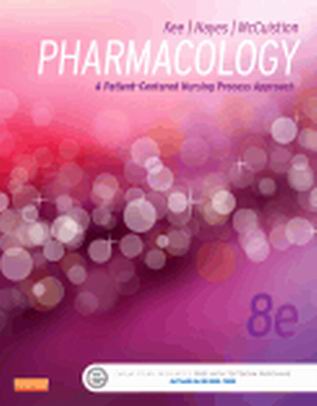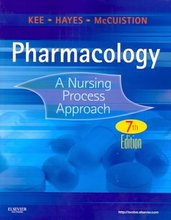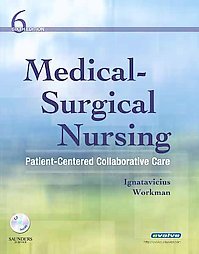Test Bank for Pharmacology A Patient-Centered Nursing Process Approach, 8th Edition, Linda McCuistion, Joyce Kee, Evelyn Hayes 148-8
$55.00 Original price was: $55.00.$29.99Current price is: $29.99.
Test Bank for Pharmacology A Patient-Centered Nursing Process Approach, 8th Edition, Linda McCuistion, Joyce Kee, Evelyn Hayes, 148-8,
This is completed downloadable of Test Bank for Pharmacology A Patient-Centered Nursing Process Approach, 8th Edition, Linda McCuistion, Joyce Kee, Evelyn Hayes 148-8

Product Details:
- ISBN-10 : 1455751480
- ISBN-13 : 978-1455751488
- Author: Linda McCuistion, Joyce Kee, Evelyn Hayes
Prepare to administer drugs safely by mastering key pharmacology concepts and drug calculation skills! Pharmacology: A Patient-Centered Nursing Process Approach, 8th Edition covers nursing pharmacology within a real-world nursing context. Using a clear, streamlined approach, this text makes it easier to understand pharmacology with a detailed unit on dosage calculations, a nursing process framework for drug therapy, and summaries of prototype drugs. Written by nursing educators Joyce Kee, Evelyn Hayes, and Linda McCuistion, this edition includes a strong QSEN focus, enhanced coverage of prioritization, and more NCLEX® Examination–style questions on the subject of pharmacology.
Table of Content:
Unit I: Introduction to Pharmacology
1. Drug Action: Pharmaceutic, Pharmacokinetic, and Pharmacodynamic Phases
2. The Drug Approval Process
3. Cultural and Pharmacogenetic Considerations
4. Drug Interactions and Over-the-Counter Drugs
5. Drugs of Abuse
6. Herbal Therapies
7. Pediatric Pharmacology
8. Geriatric Pharmacology
9. Collaboration in Community Settings NEW QSEN focus!
10. The Role of the Nurse in Drug Research
Unit II: A Nurse’s Perspective of Pharmacology
11. The Nursing Process in Patient-Centered Pharmacotherapy NEW QSEN focus!
12. Safety and Quality in Pharmacotherapy NEW QSEN focus!
13. Medication Administration
Unit III: Drug Calculations
14. Medications and Calculations
Section 14A: Systems of Measurement with Conversion
Section 14B: Methods for Calculation
Section 14C: Calculations of Oral Dosages
Section 14D: Calculations of Injectable Dosages
Section 14E: Calculations of Intravenous Fluids
Section 14F: Pediatric Drug Calculations
Unit IV: Nutrition and Electrolytes
15. Vitamin and Mineral Replacement
16. Fluid and Electrolyte Replacement
17. Nutritional Support
Unit V: Autonomic Nervous System Agents
18. Adrenergic Agonists and Adrenergic Blockers
19. Cholinergic Agonists and Anticholinergics
Unit VI: Neurologic and Neuromuscular Agents
20. Central Nervous System Stimulants
21. Central Nervous System Depressants
22. Anticonvulsants
23. Drugs for Neurological Disorders: Parkinsonism and Alzheimer’s Disease
24. Drugs for Neuromuscular Disorders: Myasthenia Gravis, Multiple Sclerosis, and Muscle Spasms
Unit VII: Pain and Inflammation Management Agents
25. Antiinflammatory Drugs
26. Nonopioid and Opioid Analgesics
Unit VIII: Psychiatric Agents
27. Antipsychotics and Anxiolytics
28. Antidepressants and Mood Stabilizers
Unit IX: Antibacterial and Antiinfective Agents
29. Penicillins and Cephalosporins
30. Macrolides, Tetracyclines, Aminoglycosides, and Fluoroquinolones
31. Sulfonamides
Unit X: Additional Antiinfective Agents
32. Antituberculars, Antifungals, Peptides, and Metronidazole
33. Antivirals, Antimalarials, and Anthelmintics
34. Drugs for Urinary Tract Disorders
Unit XI: Immunologic Agents
35. HIV- and AIDS-Related Drugs
36. Vaccines
Unit XII: Antineoplastic Agents
37. Anticancer Drugs
38. Targeted Therapies to Treat Cancer
39. Biologic Response Modifiers
Unit XIII: Respiratory Agents
40. Drugs for Upper Respiratory Disorders
41. Drugs for Lower Respiratory Disorders
Unit XIV: Cardiovascular Agents
42. Cardiac Glycosides, Antianginals, and Antidysrhythmics
43. Diuretics
44. Antihypertensives
45. Anticoagulants, Antiplatelets, and Thrombolytics
46. Antihyperlipidemics and Peripheral Vasodilators
Unit XV: Gastrointestinal Agents
47. Drugs for Gastrointestinal Tract Disorders
48. Antiulcer Drugs
Unit XVI: Eye, Ear, and Skin Agents
49. Drugs for Eye and Ear Disorders
50. Drugs for Dermatologic Disorders
Unit XVII: Endocrine Agents
51. Endocrine Drugs: Drugs for Pituitary, Thyroid, Parathyroid, and Adrenal Disorders
52. Antidiabetics
Unit XVIII: Reproductive and Gender-Related Agents
53. Female Reproductive Cycle I: Pregnancy and Preterm Labor Drugs
54. Female Reproductive Cycle II: Labor, Delivery, and Preterm Neonatal Drugs
55. Postpartum and Newborn Drugs
56. Drugs for Women’s Reproductive Health and Menopause
57. Drugs for Men’s Health and Reproductive Disorders
58. Drugs for Disorders in Women’s Health, Infertility, and Sexually Transmitted Infections
Unit XIX: Emergency Agents
59. Adult and Pediatric Emergency Drugs
Appendices
A: Therapeutic Drug Monitoring
B: Potential Weapons of Bioterrorism
References
People Also Search:
pharmacology a patient centered nursing process approach 8th edition
pharmacology a patient centered nursing process approach
pharmacology a patient centered nursing process approach 8th edition download scribd
pharmacology a patient centered nursing process approach 8th edition testbank download pdf
You may also like…
Test Bank
Medical-Surgical Nursing Patient-Centered Collaborative Care Ignatavicius 6th Edition Test Bank
Test Bank
Test Bank for Medical-Surgical Nursing: Patient-Centered Collaborative Care 8th Edition Ignatavicius












